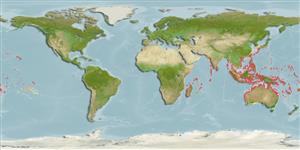>
Eupercaria/misc (Various families in series Eupercaria) >
Labridae (Wrasses) > Corinae
Etymology: Thalassoma: Greek, thalassa = the sea + Greek, soma = body; the colour of the sea (Ref. 45335).
More on author: Bleeker.
Environment: milieu / climate zone / depth range / distribution range
Ecologia
marino associati a barriera corallina; distribuzione batimetrica 0 - 15 m (Ref. 1602), usually 1 - 15 m (Ref. 27115). Subtropical; 24°C - 28°C (Ref. 27115); 30°N - 32°S
Indo-Pacific: Somalia (Ref. 30573) and South Africa (Ref. 4392) to the Line, Marquesan, and Tuamoto islands, north to southern Japan, south to Rowley Shoals, northern New Zealand and Lord Howe and Rapa islands.
Size / Peso / Age
Maturity: Lm ? range ? - ? cm
Max length : 16.0 cm SL maschio/sesso non determinato; (Ref. 9823)
Spine dorsali (totale) : 8; Raggi dorsali molli (totale) : 13; Spine anali: 3; Raggi anali molli: 10 - 11. Juveniles easily identified by the color pattern and rounded snout. Males become brightly colored and head usually green with a yellow band following on the body (Ref. 48636). Head naked, no scales dorsally on opercle. Initial phase with a broad blackish stripe from snout through eye to caudal-fin base (Ref 9823).
Occurs in aggregations over shallow lagoon and seaward reefs (Ref. 9710) and on reef flats (Ref. 9823). Feeds mainly on crustacean zooplankton (Ref. 1602). Spawns at dusk above reefs (Ref. 90102). Rarely marketed (Ref. 2334). Minimum depth reported taken from Ref. 128797.
Life cycle and mating behavior
Maturità | Riproduzione | Deposizione | Uova | Fecundity | Larve
Oviparous, distinct pairing during breeding (Ref. 205).
Randall, J.E., G.R. Allen and R.C. Steene, 1990. Fishes of the Great Barrier Reef and Coral Sea. University of Hawaii Press, Honolulu, Hawaii. 506 p. (Ref. 2334)
IUCN Red List Status (Ref. 130435: Version 2024-1)
Threat to humans
Harmless
Human uses
Pesca: di nessun interesse; Acquario: Commerciale
Strumenti
Special reports
Download XML
Fonti Internet
Estimates based on models
Preferred temperature (Ref.
123201): 24.8 - 29.3, mean 28.4 °C (based on 3194 cells).
Phylogenetic diversity index (Ref.
82804): PD
50 = 0.5000 [Uniqueness, from 0.5 = low to 2.0 = high].
Bayesian length-weight: a=0.00933 (0.00519 - 0.01678), b=3.06 (2.91 - 3.21), in cm total length, based on LWR estimates for this species & Genus-body shape (Ref.
93245).
Trophic level (Ref.
69278): 3.1 ±0.2 se; based on diet studies.
Resilienza (Ref.
120179): Medio, tempo minimo di raddoppiamento della popolazione 1.4 - 4.4 anni (Preliminary K or Fecundity.).
Fishing Vulnerability (Ref.
59153): Low vulnerability (10 of 100).
Nutrients (Ref.
124155): Calcium = 57.7 [23.1, 122.2] mg/100g; Iron = 0.812 [0.431, 1.709] mg/100g; Protein = 18.8 [15.9, 21.1] %; Omega3 = 0.203 [0.107, 0.398] g/100g; Selenium = 9.28 [4.34, 20.90] μg/100g; VitaminA = 140 [38, 589] μg/100g; Zinc = 1.18 [0.73, 2.12] mg/100g (wet weight);
